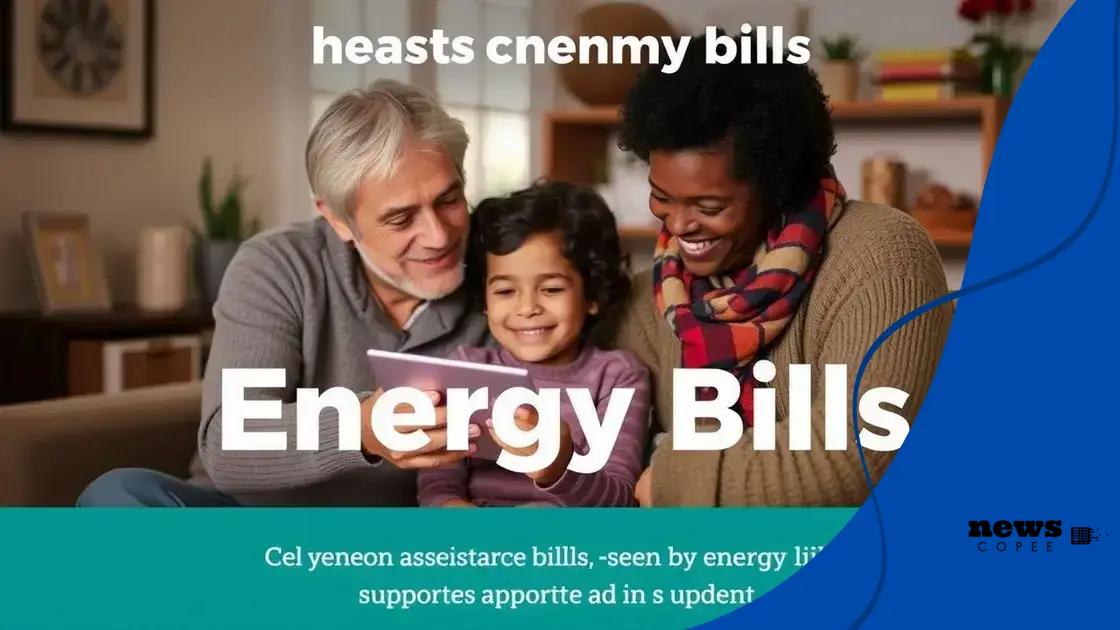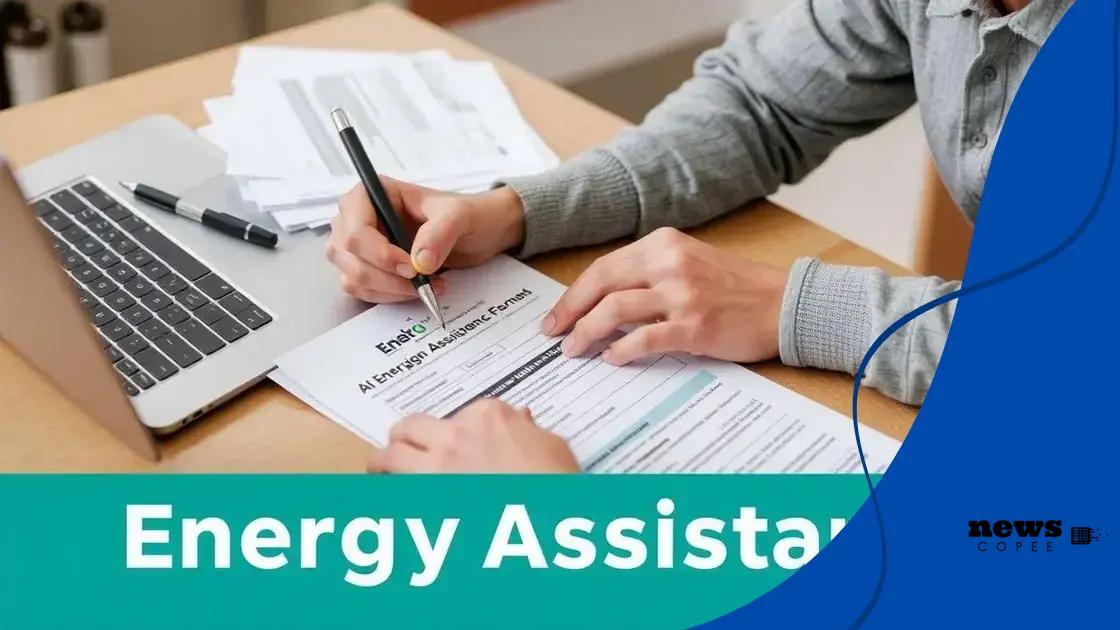Energy assistance programs for low-income households expanded

Energy assistance programs for low-income households provide financial support, improve home safety and comfort, and connect families with local resources to effectively manage their energy costs.
Energy assistance programs for low-income households expanded to address the growing need for help with utility bills. Many families struggle to keep their homes comfortable year-round, especially during extreme weather. What do these programs offer, and how can they make a difference in your life?
Understanding energy assistance programs
Understanding energy assistance programs is essential for families struggling to pay their utility bills. These programs offer support to low-income households, ensuring they can stay comfortable and safe in their homes, especially during extreme seasons.
One of the key components of these programs is the financial aid they provide. This assistance can come in various forms, such as direct payments to utility companies or help with weatherization measures to make homes more energy-efficient.
Types of Energy Assistance Programs
There are several types of energy assistance programs available, each designed to meet different needs. Some of the most common include:
- Low-Income Home Energy Assistance Program (LIHEAP): A federal program that helps families afford heating and cooling costs.
- Weatherization Assistance Program: Offers services to improve the energy efficiency of homes, reducing energy consumption.
- Local Utility Programs: Many utility companies have their own assistance programs that can help customers with bills or payment plans.
Each program has its own eligibility criteria, often based on income, household size, and energy costs. It’s crucial for families to understand these requirements to take full advantage of the support available. Applying for assistance can seem daunting, but most programs provide clear guidelines on how to get started.
In addition to financial support, these programs often include resources for education on saving energy and managing utility costs. Families can learn about simple changes they can make in their homes that not only help reduce bills but also contribute to a more sustainable future.
Eligibility criteria for low-income households
Eligibility criteria for low-income households aiming to access energy assistance programs vary by program and location. Understanding these requirements is crucial for families seeking help.
Most often, eligibility is based on household income relative to the federal poverty level. This means that an applicant’s income must be below a certain threshold to qualify. Additionally, household size plays an important role; larger families may have higher income limits.
Common Eligibility Requirements
Here are some typical criteria you’ll find:
- Income Limits: Most programs set specific income limits based on family size, generally around 150% of the federal poverty level.
- Residency: Applicants usually need to reside in the state where they are applying for assistance and show proof of residency.
- Utility Payment History: Some programs may check the applicant’s history with utility payments to ensure they are in need of assistance.
It’s vital for families to gather necessary documentation before applying. Documents typically include proof of income, identification, and residency verification. Knowing what to bring can make the application process smoother.
Moreover, some programs offer priority for vulnerable populations, such as the elderly, disabled individuals, or families with young children. This helps ensure that those most in need can access the support promptly.
How to apply for energy assistance

Applying for energy assistance can seem overwhelming, but it’s a straightforward process when you know what to do. Many programs are designed to make the application process easy and accessible for families in need.
To start, gather all necessary documents. You will typically need proof of income, identification, and your energy bill. This documentation helps demonstrate your eligibility for assistance.
Steps to Apply
Here are simple steps to follow when applying:
- Research Programs: Look for local energy assistance programs available in your area. Websites like the Department of Energy can help you find information.
- Complete Application Forms: Most programs offer forms you can fill out online or in person. Make sure to complete them accurately.
- Submit Documents: Attach the required documents and submit your application. Be mindful of deadlines to ensure your application is considered.
Once your application is submitted, you may need to wait for approval. Some programs will contact you for additional information, while others will send a notice with their decision. It’s essential to stay in touch with the program during this time.
If your application is approved, you will receive details on the assistance offered, such as payment amounts or services provided. If denied, don’t hesitate to ask for an explanation and seek help to understand your options.
Benefits of these programs for families
The benefits of energy assistance programs for families are significant and can greatly impact their quality of life. These programs help relieve some of the financial burdens associated with energy costs, especially during extreme weather conditions.
One of the main advantages is the financial relief that comes from reduced utility expenses. Families can use the savings for other essential needs, like food and healthcare. This can be crucial for low-income households that struggle to make ends meet.
Improved Comfort and Safety
In addition to financial help, these programs often provide ways to enhance household comfort and safety. Assistance may include:
- Weatherization services: Making homes more energy-efficient by improving insulation, sealing leaks, and upgrading heating systems.
- Reducing health risks: Maintaining suitable temperatures helps prevent heat-related illnesses in the summer and hypothermia in the winter.
- Access to necessary appliances: Some programs provide families with energy-efficient appliances, which can lead to further savings on utility bills.
Furthermore, participating in energy assistance programs often comes with educational resources. Families receive information on energy conservation methods and ways to better manage their energy usage. This knowledge empowers them to make informed decisions, resulting in lower bills in the long run.
Moreover, these programs can help connect families with other social services, such as food assistance or job training programs. This holistic approach addresses multiple aspects of a family’s well-being, providing a safety net during challenging times.
Local resources for energy support
Accessing local resources for energy support can be life-changing for families struggling to pay their energy bills. Many communities offer various services and programs tailored to assist low-income households.
A great starting point is your local government agencies, which often run programs aimed at helping families manage their energy costs. These agencies can provide information about available assistance and guide you through the application process.
Community Organizations
In addition to government support, many nonprofit organizations and community groups provide valuable resources:
- Energy Assistance Programs: Local charities may also offer funds specifically for utility bills.
- Food Banks: Some food banks provide information about energy assistance and can connect families to local resources.
- Faith-Based Organizations: Many churches and religious groups have outreach programs that help with utility payments or offer direct help.
Another helpful resource is your utility provider. Most companies have customer assistance programs designed to help eligible customers maintain essential utility services. These programs may include payment plans or discounts for qualifying families.
Local coalitions also work to raise awareness about available support options. These organizations often partner with various stakeholders to create events, workshops, or informational sessions on navigating energy assistance programs. Attending such events can provide helpful insights into where to find support.
Finally, online resources can give you quick access to information. Websites dedicated to energy assistance often list local resources, making it simple to find support in your area. All these avenues together create a robust network of assistance, ensuring that families have the help they need.
FAQ – Frequently Asked Questions About Energy Assistance Programs
What is energy assistance?
Energy assistance helps low-income families pay their energy bills and can include financial support and weatherization services.
Who is eligible for energy assistance programs?
Eligibility usually depends on household income, size, and specific program guidelines, often requiring the household income to be below a certain threshold.
How can I apply for energy assistance?
To apply, gather required documents, such as proof of income and utility bills, then either apply online or visit your local assistance office.
What benefits do these programs provide?
These programs can provide financial relief, improve home comfort, and offer educational resources on energy conservation.
